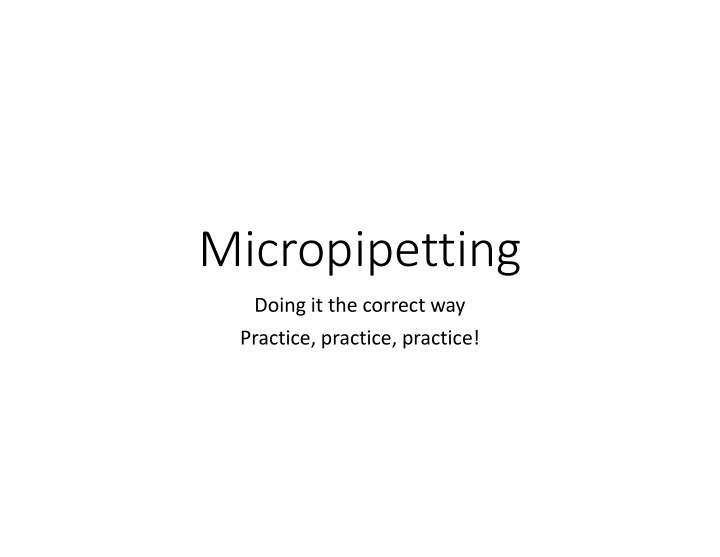



Micropipetting Doing it the correct way Practice, practice, practice!
Why Take the Time to Practice? • Micropipetting is the foundation to many future experiments • Correct pipetting insures correct volumes which creates a greater chance for success! • Practice allows muscle memory to develop • CORRECT PIPETTING is crucial – learn to do this early on so that there’s good muscle memory, good habits and a smooth routine
Long Video on Good Pipetting Technique https://www.youtube.com/watch?v=p-OPOYbeZP0
Short Video on Good Pipetting Technique https://www.youtube.com/watch?v=uddfQmLx-yE
Micropipetting – 10 Easy Steps 1. SELECT the correct size micropipette for the volume you need 2. SET the micropipette to the appropriate volume by adjusting the dial 3. PLACE a clean, disposable tip on the micropipette 4. PRESS the plunger down to the first stop and hold… 5. INSERT the tip beneath the surface of the liquid 6. TRANSFER liquid up into the pipette tip by slowly releasing the plunger 7. DISPENSE liquid by pressing the plunger to the first stop 8. EXPEL any remaining liquid by pressing the plunger to the second stop 9. RAISE the pipette tip above the liquid sample before releasing the plunger 10.DISCARD the tip by pressing the ejector button n o t t u B r o t c e j E p y a i T l p s i D l a i D n o p t t i u T e B r l b e a g s n o u p l P s i D ial d
Lab Activity Pipette Card Sort/Match Match the micropipette with the correct volume in the microtube
Color by Numbers – Pipette Art!
Micro Well Plate (aka: microplate) 1 - 12 12 wells across 8 wells down A - H
Well locations can be described with Coordinates
What are the positions of the grey boxes? A1
Pipette Art Rocket Butterfly Car Cat t H G F E D C B A Flower 1 Moon & Sun 2 3 4 5 6 7 8 9 10 11 12
Key Points to Remember � Know what size pipette you are using before you set the dial � The highest setting for each pipette is: For the P20: the tens place o For the P200: the hundreds place o o For the P1000: the thousands place � Remember that the dial can have the same reading, but if the size pipette is different, the volume will be different. 6.5 μL, 65 μL, 650 μL � all look the same on the dial � By knowing the maximum volume of the micropipette (usually written on the top), you can figure out what each of the digits on the readout means. Now try setting the dial � Precision Pipetting Cards Micropipette Practice using the P-200 50 µ L 75 µ L 100 µ L 150 µ L 200 µ L O O O O O
Roy Gee Biv’s Challenge Page 9
Recommend
More recommend